Abstract
A new class of truncated M-fractional exact soliton solutions for a mathematical physics model known as a truncated M-fractional (1+1)-dimensional nonlinear modified mixed-KdV model are achieved. We obtain these solutions by using a modified extended direct algebraic method. The obtained results consist of trigonometric, hyperbolic trigonometric and mixed functions. We also discuss the effect of fractional order derivative. To validate our results, we utilized the Mathematica software. Additionally, we depict some of the obtained kink, periodic, singular, and kink-singular wave solitons, using two and three dimensional graphs. The obtained results are useful in the fields of fluid dynamics, nonlinear optics, ocean engineering and others. Furthermore, these employed techniques are not only straightforward, but also highly effective when used to solve non-linear fractional partial differential equations (FPDEs).
1. Introduction
Fractional calculus have much importance in many fields of science and engineering like; fluid dynamics, plasma physics, optical fibers, chemistry, biology, economics etc. Naturally occurring phenomenon are represented in the form of fractional partial differential equations (FPDEs). Distinct techniques have been developed to the numerical and exact solutions of the FPDEs. For example, generalized exponential rational function method [], extended trial equation technique [], improved Fan sub-equation technique [], modified extended tanh function technique [], multi exp-function scheme [], generalized double auxiliary equation technique [], Bäcklund transformations [], transformed rational function method [], Darboux transformation [] etc.
In our study, we utilize a straightforward and powerful method: modified extended direct algebraic method. This method has various applications. For example, optical soliton solutions to the nonlinear Schrödinger equation are obtained [], kink wave and lump wave solutions for the fractional coupled Higgs system are achieved [], bright and dark-singular combo soliton solutions for the Lakshmanan-Porseizian-Daniel model are gained [], singular, dark and bright wave solutions for the Gerdjikov-Ivanov equation are gained [], singular-periodic, rational, exponential and other solutions for the highly dispersive perturbed nonlinear Schrödinger equation are obtained [], dark, bright, singular and other kinds of soliton solutions for the extended (2+1)-dimensional perturbed nonlinear Schrödinger equation are gained [].
One of the mathematical physics model; (1+1)-dimensional modified mixed Korteweg-de Vries (mmKdV) equation. This model have much importance in nonlinear optics, fluid dynamics and other fields. This model is solved by different techniques earlier. For example; distinct kinds of topological and non-topological soliton solutions are gained by applying the extended rational sinh-cosh technique, extended rational sine-cosine technique and polynomial function technique [], dark, bright and periodic wave solutions are obtained by utilizing the Homogenous balance technique [] etc.
The objective of our study is to investigate some new types of M-fractional exact soliton solutions for the (1+1)-dimensional non-linear modified mixed-KdV model by employing the modified extended direct algebraic method and show the effect of truncated M-fractional derivative on the solutions.
This paper contains the various sections; Modified extended direct algebraic method is explained in Section 2, concerning model and it’s mathematical analysis are explained in Section 3, exact soliton solutions are gained in Section 4, some gained results are shown graphically in Section 5, conclusion in Section 6.
2. Modified Extended Direct Algebraic Method
The fundamental steps of this technique are given as []:
- Step 1: Considering a NLPDE:
here represents a wave profile. Consider a wave transformations:
Using Equation (2) into Equation (1), a NLODE is gained
Step 2: Consider Equation (3) has solution given as:
here are the unknowns and . A new profile satisfies the ODE:
where p, q and r are the constants and . Notice that Equation (5) has solutions for the following different cases:
- Case 1: if and , we have
Step 3: Begin this step by putting Equation (4) along Equation (5) into Equation (3). Next sum coefficients of each term, then set the coefficients of same order equal to zero to gain a set of equations in and . By manipulating this set of equations, results for the unknowns are found. Step 4: Inserting Equation (4), where the values of and are now known into Equation (3) will yield solutions to Equation (1).
3. Model Description and Mathematical Analysis
Let us assume a truncated M-fractional (1+1)-dimensional nonlinear modified mixed-KdV model given as:
where
where is a truncated Mittag-Leffler (TML) function mention in [,].
Here is a wave function. Equation (1) represents a modified mixed Korteweg-de Vries (mmKdV) model which explains the flat-topped electron distribution having a stronger non-linearity that corresponds to the small-width and high-velocity of the wave [,,]. To find the solutions of Equation (1), we suppose the following:
By putting Equation (45) into Equation (43), yields
Consider a wave transformation given as:
here represents the wave-amplitude and denotes the wave velocity.
4. Exact Soliton Solutions
For , Equation (4) changes into
Putting Equation (49) along Equation (5) into Equation (48), we obtain the following sets for discussion.
- Set 1:
Case 1: if and , we have
where .
- Case 2:
- Case 8:
Case 11:
Case 12:
Set 2:
Case 1:
where .
- Case 2:
- Case 3:
- Case 2:
- Case 3:
- Case 2:
- Case 3:
- Case 2:
- Case 3:
5. Physical Behavior of Solutions
In this portion, we presenta the behavior of our gained kink, periodic, singular, and kink-singular solitons solutions are shown in the following Figures. Figure 1 illustrations a kink-singular shape of occur in Equation (51) in (a) 3-dim and (b) 2-dim graphs with . Figure 2 illustrations a kink-singular shape of occur in Equation (52) in (a) 3-dim and (b) 2-dim graphs with . Figure 3 illustrations a kink shape of occur in Equation (53) in (a) 3-dim and (b) 2-dim graphs with . (Figure 4) illustrations a kink shape of occur in Equation (56) in (a) 3-dim and (b) 2-dim graphs with . Figure 5 illustrations a kink-singular shape of occur in Equation (57) in (a) 3-dim and (b) 2-dim graphs with . Figure 6 illustrations a periodic shape of occur in Equation (60) in (a) 3-dim and (b) 2-dim graphs with . Figure 7 illustrations a singular shapeof occur in Equation (61) in (a) 3-dim and (b) 2-dim graphs with .
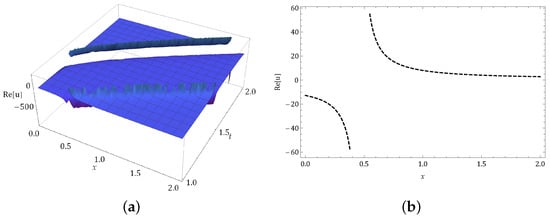
Figure 1.
Graph of occur in Equation (51) in (a) 3-dim and (b) 2-dim graphs.
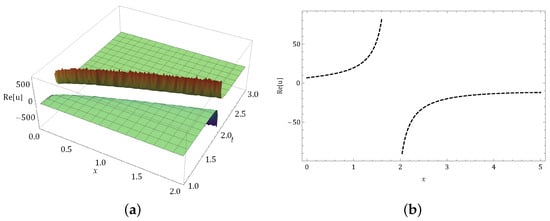
Figure 2.
Graph of occur in Equation (52) in (a) 3-dim and (b) 2-dim graphs.
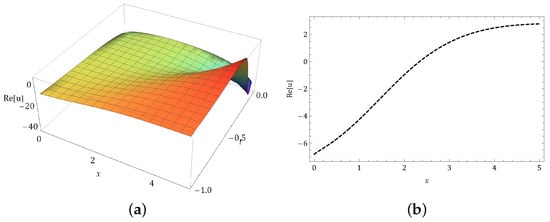
Figure 3.
Graph of occur in Equation (53) in (a) 3-dim and (b) 2-dim graphs.
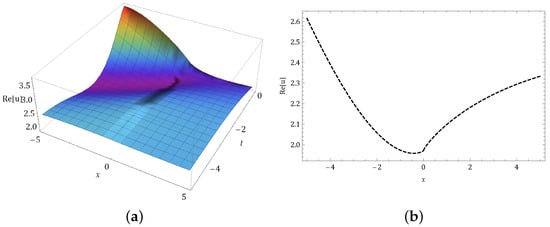
Figure 4.
Graph of occur in Equation (56) in (a) 3-dim and (b) 2-dim graphs.
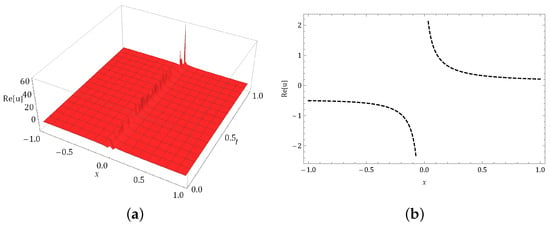
Figure 5.
Graph of occur in Equation (57) in (a) 3-dim and (b) 2-dim graphs.
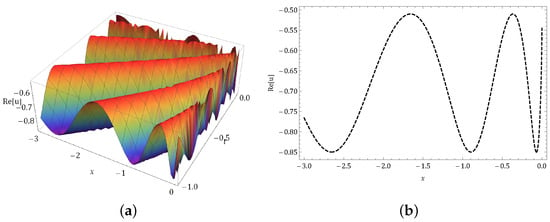
Figure 6.
Graph of occur in Equation (60) in (a) 3-dim and (b) 2-dim graphs.

Figure 7.
Graph of occur in Equation (61) in (a) 3-dim and (b) 2-dim graphs.
6. Conclusions
A new class of truncated M-fractional exact soliton solutions for a truncated M-fractional (1+1)-dimensional nonlinear modified mixed-KdV model are obtained successfully. For this aim; modified extended direct algebraic method is used. The obtained results including the kink, periodic, singular, and kink-singular soliton solutions. We also discuss the effect of fractional order derivative. To validate as well as to obtain our results, we utilized the Mathematica software. Additionally, we depict some of the obtained wave solitons, using two and three dimensional graphs. The obtained results are useful in the fields of fluid dynamics, nonlinear optics, ocean engineering and others. Furthermore, these employed techniques are not only straightforward, but also highly effective when used to solve non-linear fractional partial differential equations (FPDEs).
Author Contributions
Conceptualization, A.K.A. and M.-u.-D.J.; methodology, A.K.A. and M.-u.-D.J.; writing—original draft preparation, A.K.A. and M.-u.-D.J.; investigation, A.K.A. and M.-u.-D.J.; visualization, A.K.A. and M.-u.-D.J.; writing—review and editing, A.K.A. and M.-u.-D.J. All authors have read and agreed to the published version of the manuscript.
Funding
This work was supported by the Deanship of Scientific Research, Vice Presidency for Graduate Studies and Scientific Research, King Faisal University, Saudi Arabia [Grant No. 6116].
Data Availability Statement
Data are contained within the article.
Acknowledgments
The authors are thankful to the anonymous reviewers for their valuable suggestions and comments to improve the paper.
Conflicts of Interest
The authors declare that they have no conflicts of interest.
References
- Kumar, S.; Kumar, A.; Wazwaz, A.M. New exact solitary wave solutions of the strain wave equation in microstructured solids via the generalized exponential rational function method. Eur. Phys. J. Plus 2020, 135, 870. [Google Scholar] [CrossRef]
- Akram, G.; Sadaf, M.; Arshed, S.; Latif, R.; Inc, M.; Alzaidi, A.S. Exact traveling wave solutions of (2+1)-dimensional extended Calogero–Bogoyavlenskii–Schiff equation using extended trial equation method and modified auxiliary equation method. Opt. Quantum Electron. 2024, 56, 424. [Google Scholar] [CrossRef]
- Wang, H. Exact traveling wave solutions of the generalized fifth-order dispersive equation by the improved Fan subequation method. Math. Methods Appl. Sci. 2024, 47, 1701–1710. [Google Scholar] [CrossRef]
- Hussein, H.H.; Ahmed, H.M.; Alexan, W. Analytical soliton solutions for cubic-quartic perturbations of the Lakshmanan-Porsezian-Daniel equation using the modified extended tanh function method. Ain Shams Eng. J. 2024, 15, 102513. [Google Scholar] [CrossRef]
- Eidinejad, Z.; Saadati, R.; Li, C.; Inc, M.; Vahidi, J. The multiple exp-function method to obtain soliton solutions of the conformable Date–Jimbo–Kashiwara–Miwa equations. Int. J. Mod. Phys. B 2024, 38, 2450043. [Google Scholar] [CrossRef]
- Gasmi, B.; Moussa, A.; Mati, Y.; Alhakim, L.; Baskonus, H.M. Bifurcation and exact traveling wave solutions to a conformable nonlinear Schrödinger equation using a generalized double auxiliary equation method. Opt. Quantum Electron. 2024, 56, 18. [Google Scholar] [CrossRef]
- Ma, W.X.; Fuchssteiner, B. Explicit and exact solutions to a Kolmogorov-Petrovskii-Piskunov equation. Int. J. Non-Linear Mech. 1996, 31, 329–338. [Google Scholar] [CrossRef]
- Ma, W.X.; Lee, J.H. A transformed rational function method and exact solutions to the (3+1)-dimensional Jimbo–Miwa equation. Chaos Solitons Fractals 2009, 42, 1356–1363. [Google Scholar] [CrossRef]
- Ma, W.X. Binary Darboux transformation of vector nonlocal reverse-time integrable NLS equations. Chaos Solitons Fractals 2024, 180, 114539. [Google Scholar] [CrossRef]
- Ghayad, M.S.; Badra, N.M.; Ahmed, H.M.; Rabie, W.B. Derivation of optical solitons and other solutions for nonlinear Schrödinger equation using modified extended direct algebraic method. Alex. Eng. J. 2023, 64, 801–811. [Google Scholar] [CrossRef]
- Bilal, M.; Iqbal, J.; Ali, R.; Awwad, F.A.; AIsmail, E.A. Exploring Families of Solitary Wave Solutions for the Fractional Coupled Higgs System Using Modified Extended Direct Algebraic Method. Fractal Fract. 2023, 7, 653. [Google Scholar] [CrossRef]
- Hubert, M.B.; Betchewe, G.; Justin, M.; Doka, S.Y.; Crepin, K.T.; Biswas, A.; Zhou, Q.; Alshomrani, A.S.; Ekici, M.; Moshokoa, S.P.; et al. Optical solitons with Lakshmanan–Porsezian–Daniel model by modified extended direct algebraic method. Optik 2018, 162, 228–236. [Google Scholar] [CrossRef]
- Ahmed, M.S.; Zaghrout, A.S.; Ahmed, H.M.; Arnous, A.H. Optical soliton perturbation of the Gerdjikov–Ivanov equation with spatio-temporal dispersion using a modified extended direct algebraic method. Optik 2022, 259, 168904. [Google Scholar] [CrossRef]
- Rabie, W.B.; Hussein, H.H.; Ahmed, H.M.; Alnahhass, M.; Alexan, W. Abundant solitons for highly dispersive nonlinear Schrödinger equation with sextic-power law refractive index using modified extended direct algebraic method. Alex. Eng. J. 2024, 86, 680–689. [Google Scholar] [CrossRef]
- Ali, M.H.; El-Owaidy, H.M.; Ahmed, H.M.; El-Deeb, A.A.; Samir, I. Solitons and other wave solutions for (2+1)-dimensional perturbed nonlinear Schrödinger equation by modified extended direct algebraic method. J. Opt. 2023, 1–9. [Google Scholar] [CrossRef]
- Alquran, M.; Ali, M.; Jadallah, H. New topological and non-topological unidirectional-wave solutions for the modified-mixed KdV equation and bidirectional-waves solutions for the Benjamin Ono equation using recent techniques. J. Ocean. Eng. Sci. 2022, 7, 163–169. [Google Scholar] [CrossRef]
- Butt, A.R.; Raza, N.; Ahmad, H.; Ozsahin, D.U.; Tchier, F. Different solitary wave solutions and bilinear form for modified mixed-KDV equation. Optik 2023, 287, 171031. [Google Scholar]
- Sulaiman, T.A.; Yel, G.; Bulut, H. M-fractional solitons and periodic wave solutions to the Hirota- Maccari system. Mod. Phys. Lett. B 2019, 33, 1950052. [Google Scholar] [CrossRef]
- Sousa, J.V.D.C.; de Oliveira, E.C. A new truncated M-fractional derivative type unifying some fractional derivative types with classical properties. Int. J. Anal. Appl. 2018, 16, 83–96. [Google Scholar]
- Tagare, S.G.; Chakrabarti, A. Solution of a generalized Korteweg—de Vries equation. Phys. Fluids 1974, 17, 1331–1332. [Google Scholar] [CrossRef]
- Das, G.C.; Tagare, S.G.; Sarma, J. Quasipotential analysis for ion-acoustic solitary waves and double layers in plasmas. Planet. Space Sci. 1998, 46, 417–424. [Google Scholar] [CrossRef]
- Das, G.C.; Tagare, S.G.; Sarma, J. Solitary wave solutions for the KdV-type equations in plasma: A new approach with the Kudryashov function. Eur. Phys. J. Plus 2021, 136, 226. [Google Scholar]
Disclaimer/Publisher’s Note: The statements, opinions and data contained in all publications are solely those of the individual author(s) and contributor(s) and not of MDPI and/or the editor(s). MDPI and/or the editor(s) disclaim responsibility for any injury to people or property resulting from any ideas, methods, instructions or products referred to in the content. |
© 2024 by the authors. Licensee MDPI, Basel, Switzerland. This article is an open access article distributed under the terms and conditions of the Creative Commons Attribution (CC BY) license (https://creativecommons.org/licenses/by/4.0/).